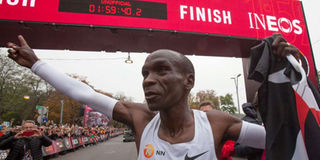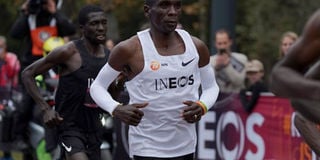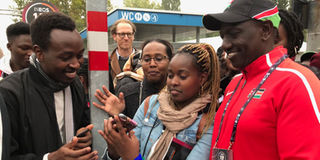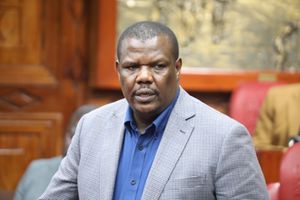Kipchoge shows there are no limits to what we can achieve
What you need to know:
- Eliud Kipchoge has eloquently shown the world once more how transcendent sports can be in the lives of people without regard to their situation. His marathon achievement on October 12 displayed the unifying power of sports across the world as millions of watching fans cheered his triumph as their own victory
Once every few decades comes a sports hero, a legend who transforms and ignites their discipline far beyond its traditional boundaries to inspire millions of people who would otherwise have little interest in that sport.
In football, we had the remarkable Edson Arantes do Nascimento, better known as Pele, and the mercurial Diego Maradona. In boxing, we had the poetic Muhammad Ali and the rage of “Iron” Mike Tyson. In basketball, we had the versatile Michael Jordan.
In athletics, we had the exciting sprinter Usain Bolt. In golf, the resilient Tiger Woods. In tennis, the dominant sisters Venus and Serena Williams.
In the marathon, we now have the philosophical Eliud Kipchoge.

Kenya's Eliud Kipchoge celebrates after busting the mythical two-hour barrier for the marathon on October 12 2019 in Vienna. Kipchoge on Saturday made history, busting the mythical two-hour barrier for the marathon on a specially prepared course at Prater park with an unofficial time of 1:59:40.2. PHOTO | ALEX HALADA |
The date is October 12, 2019. The time is 8am, the temperature is nine degrees celcius at the Reichsbrücke (German for Imperial Bridge) in Vienna, Austria.
GREY CHILLY MORNING
Kipchoge and seven members of his elite team of pacemakers jog up and down a 50-metre stretch behind the starting point of the “INEOS 1:59 Challenge” race on the gentle slope of the bridge.
To their left, the 119-year old St. Francis of Assisi Church can barely be seen through the mist lifting slowly from Europe’s second-longest river, the Danube.
Hundreds of excited fans make their way through the grey chilly morning to the bridge. Thousands more line up the race route on both sides of the iconic Hauptallee in the Prater Park, known to local runners as “the green lung of Vienna” due to the fresh air from the trees along the 4.3-kilometre straight avenue.
The anticipation among the fans is palpable as they seek vantage positions before the start of the race.
Many are convinced that they are on the verge of witnessing a once in a lifetime sporting spectacle. Among them are scores of Kenyans who have travelled from neighbouring countries and others all the way from Kenya, eager to cheer their national legend.
Eliud Kipchoge, the world marathon record holder, is once more set to make athletics history.
At precisely 15 minutes past 8am, the announcer counts down the clock by 15 seconds.

Eliud Kipchoge (in white singlet) runs flanked by pacesetters during the INEOS 1:59 Challenge at Prater Park in Vienna, Austria on October 12, 2019. PHOTO | INEOS 1:59 CHALLENGE
HISTORIC FEAT
The crowds cheer, and the race is on. One hour, 59 minutes and 40.2 seconds later, Eliud spectacularly sprints through the finish line at the Prater Park becoming the first man in history to run a marathon in under two hours.
The watching world collectively bursts out in celebration peppered with a sense of relief. Athletics’ last great barrier has been shattered, paving the way into a new frontier no one can quite define.
For several months, the event organizers have rallied behind Kipchoge’s personal philosophy that “no human is limited” to galvanise the world around a profound idea, an experiment in stretching the capabilities of the human body.
The one thing that was never in doubt among supporters and cynics was that if there was anyone capable of running a marathon in under two hours, it had to be Kipchoge.
Sir Jim Ratcliffe, Britain’s richest man and founder of INEOS, expressed his confidence and trust in Kipchoge’s ability to run a sub-two marathon right from the announcement of the 1:59 Challenge race in May 2019.
“Eliud is the best marathoner there’s ever been, and he’s still getting better. He’s the only man currently who can break the two-hour barrier,” Sir Jim said.

Kenya's Eliud Kipchoge (R) celebrates with Ineos owner Jim Ratcliffe (L) after busting the mythical two-hour barrier for the marathon on October 12 2019 in Vienna
During the same occasion, Kipchoge had no hesitation in saying that he was equal to the task.
“My mind is saying that I’m going to do it. So my heart and mind is on 1:59. The secret is believing and trusting in my capabilities that I can do it,” he explained.
In writing himself into the history books, Kipchoge ran an average speed of two minutes and 50 seconds every kilometre across the entire 42-kilometre course.

Deputy President William Ruto (right) shares a light moment with Kenyans during the INEOS 1:59 Challenge at Prater Park in Vienna, Austria on October 12, 2019. PHOTO | ELIAS MAKORI |
That this feat that would commence at the Reichsbrücke was even more fascinating for someone described by sports commentators as the greatest marathoner of all time.
On October 1, 1976, shortly before five in the morning, the imposing bridge, one of the most trafficked in Vienna, unexpectedly collapsed into the river Danube killing one person.
The main reason given for the collapse was structural failure in the bearings, which was not spotted during inspection due to the massive granite mantle that surrounded them.
A new bridge was re-designed and formally opened on November 8, 1980. It remains an impressive structure used by 50,000 vehicles each day with six lanes of traffic, U-Bahn tracks, two footpaths, two-cycle paths and two utility tunnels.
FAILED TO MAKE OLYMPICS TEAM
Kipchoge’s stellar athletic career faced a near collapse in 2012, when he incredibly failed to qualify for the London Olympics as an accomplished 5,000-metre runner.
In a radical decision that would prove to be a game-changer, he switched to road running that same year starting out in the half marathon before winning the 2013 Hamburg Marathon in a course record time. From that win, Kipchoge’s marathon career took off into the stratospheres.
He has won 10 of the 11 marathons that he has participated in.
In 2016 he took the Olympic gold in Rio de Janeiro in a race where he was seemingly under no threat from the competition.
He currently holds the official world record of 2:01:39, set at the 2018 Berlin Marathon.
In contemplating Kipchoge’s extraordinary triumphs over the last six years, it’s clear that the world of sports has once more produced an iconic figure, transcending cultures, race and languages to redefine the boundaries of human achievements and inspire billions across the globe.
Only a few personalities come to mind when one reflects on the scale of what this means.
We may even have to look outside the arena of sports to find such inspiring individuals.
The world of music carries a comparable transcendent power to sports, and it, therefore, provides a notable personality we can briefly examine to comprehend Kipchoge’s influence on millions across the globe.
MICHAEL JACKSON
The late pop-musician Michael Jackson immediately stands out. His musical talent and genius were undeniable, enriching the global music industry for decades during his lifetime.
Through his music, Michael Jackson managed to transcend racial barriers to inspire millions of adoring fans across different cultures and different generations.
Shortly after his death in June 2009, American evangelist Al Sharpton described him as a truly historic figure. It may be too early to make lofty comparisons between Kipchoge and the late King of Pop, but the greatest marathoner in modern times does provide some profound and inspiring insights from his athletic achievements.
To truly understand the driving force behind this fascinating man, we need to go back and examine a few of his past philosophical thoughts and musings.
We need to appreciate the motivations that compelled him to take on the challenge of running a marathon in under two hours, succeeding on the second attempt two years after the Nike Breaking2 project where he fell short by just 26 seconds.
Immediately following that pioneering event of May, 2017, the philosopher king of the marathon simply quipped: “The world is just 26 seconds away.”
At a press briefing hosted by his local sponsors Isuzu East Africa on September 4, 2019 in Nairobi, Kipchoge powerfully explained why he was going to Vienna to make athletics history.
“I am going to Vienna to inspire a whole generation. I am going to Vienna to sell the idea that no human is limited. I am going to Vienna to inspire the human family.
“I want to inspire that journalist, lawyer, engineer, teacher, driver that when they wake up they can do more. It’s not about setting a world record but it’s about making history and inspiring the human race.”
RADICAL DECISION
The world of business can certainly learn a great deal from this excellent athlete’s training methodology, personal discipline and winning mindset.
Take for instance his radical decision to switch from his favourite track event the 5,000 metres to the marathon.
Jim Collins in his best-selling book Good to Great, Why Some Companies Make The Leap, provides two compelling approaches practiced by these successful companies that one can discern in Kipchoge’s career.
First, Jim Collins asserts that companies that made the shift from being good to later become great institutions, started by developing within their organizations the ability to confront the ‘brutal facts’.
They created a climate or environment where employees were consistently encouraged to speak up and share truth in their day to day operations, no matter how unpalatable it was to their leaders.
Secondly, in that bold process, these companies came to the realisation that if their core business did not propel them to be the best in their sectors, then they needed to change to what they could be best at, not what they were competent to do.
Finally, the companies needed to build an absolute belief in their ranks that they could become the very best in their business.
They nurtured an unfailing faith, an iron-willed self-belief that they could achieve their goals no matter how ambitious, insurmountable or wild they at first appeared to be.
In failing to qualify for the 2012 London Olympics, Kipchoge had to confront the brutal reality that he was not the best in the 5,000 metres track discipline.
While he was competent in the event, having won Olympic medals and a world championship gold in his career, he was yet to realise his full potential.
He had to make a choice between continuing in an event where he would likely not rise to dominance, or courageously try out something new where he had a chance of truly excelling. The switch to the marathon resulted in a stunning change of fortunes for the 34-year-old which culminated in the enthralling sub two-hour performance in Vienna.
In the lead up to this memorable event, he once more clarified his intentions for taking on an epic race challenge that he well knew would not be recognised as an official marathon record.
“I want to be able to show the world that when you focus on your goal, when you work hard, and when you believe in yourself, anything is possible,” he said.
The element of self-belief came out consistently in his statements when confronted with the epic INEOS 1:59 Challenge.
From the moment he announced to the world his intention to mirror what British athlete Roger Banister had achieved in 1954 running the mile in under four minutes, his simple conviction regarding what a human being could achieve with the right mindset was amazing.
“Any human being can go beyond their thoughts, but self-belief is crucial. I totally believe in myself, and in my team-mates and my training,” he said.
POWER OF TEAMWORK
Indeed, no other human endeavour demonstrates the power and benefits of teamwork as well as sports does.
One of Kipchoge's most cherished training principles is anchored around his team-mates and what they have enabled him to achieve.
“You cannot train alone and expect to run a fast time. 100 per cent of me is nothing compared to one percent of the team,” he often asserts.

Eliud Kipchoge (centre in white singlet) runs flanked by pacesetters during the INEOS 1:59 Challenge at Prater Park in Vienna, Austria on October 12, 2019. PHOTO | INEOS 1:59 CHALLENGE
Kipchoge has eloquently shown the world once more how transcendent sports can be in the lives of people without regard to their circumstances.
His marathon achievement in Vienna displayed the unifying power of sports across the world as millions of watching fans cheered his triumph as their own victory.
In Kenya, Eldoret was the epicentre of excitement with ripples of celebration going right across the country. For one tantalising day, we forgot our petty differences as we applauded our gallant son for making history and swelling our hearts with national pride.
It would be no exaggeration to suggest that Kipchoge’s achievement that Saturday morning inspired the thrilling performances of Lawrence Cherono and Brigid Kosgei the following day in the Chicago Marathon.
They were the male and female winners of the race with Kosgei winning in a world record time of 2:14:04, shattering Paula Radcliffe’s 16-year-old record of 2:15:25.
Without a doubt, there is no better case for increasing our national sports budgets, county budgets and corporate sponsorships to deliberately invest in our rich sporting talents across the country.

Uasin Gishu Governor Jackson Mandago drums up support for Eliud Kipchoge during the INEOS 1:59 Challenge at Prater Park in Vienna, Austria on October 12, 2019. PHOTO | ELIAS MAKORI |
Building on the lessons from our successful track athletes, we have in recent times also seen the immense potential in our football, rugby sevens and women’s volleyball teams.
We stand to gain immeasurably as a nation from this untapped goldmine that can radically transform the fortunes of our young people.
As Kipchoge has shown us, there are no limits to what we can achieve as Kenyans if we set our minds to a noble undertaking.
Dancan Muhindi is the Communications Manager, Isuzu East Africa. Article published with permission from theelephant.info website.




